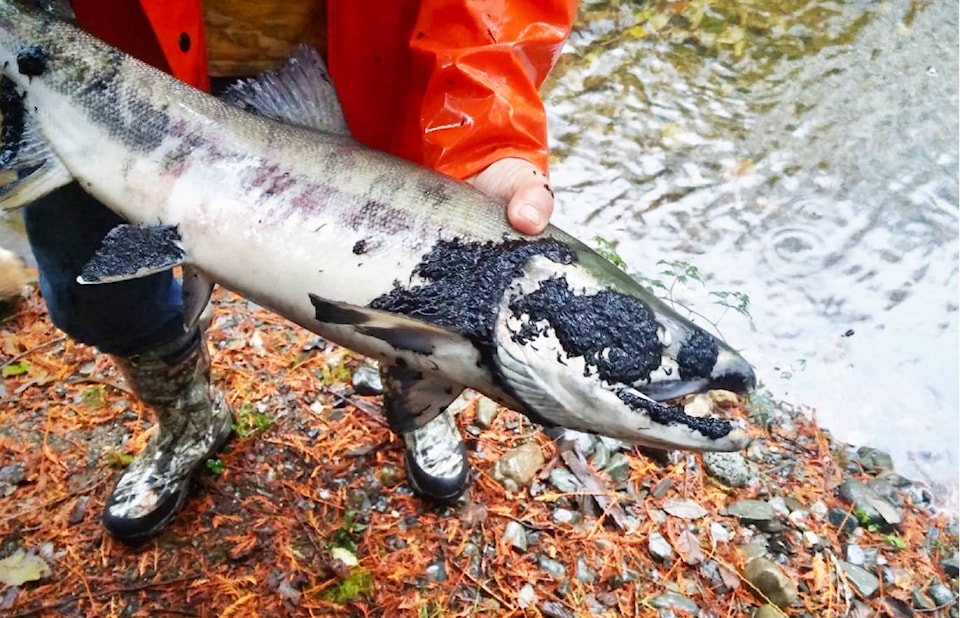When Bill Dubois started finding dead coho salmon covered in leeches on the shores and the rocky bottom of Hyacinthe Creek over on Quadra Island, he was understandably concerned. He’s been salmon-watching the creeks and streams of Quadra Island for decades and has never seen anything like it.
“I’ve seen a few leeches before on some chum, but nothing like this,” Dubois says. “The level of infestation was just really extreme. I’ve seen maybe a half dozen or 10 fish a year before, but this was more like 50 or 60 all of a sudden, just over the course of a week or so.”
He brought the situation to the attention of Lauren Miller, a director with the Quadra Island Salmon Enhancement Society, who was caught quite off guard, as well.
“There’s been nothing near me, and nothing that anyone else had reported,” Miller says. “They see them every year in the Nitinat river, and apparently they’re having a banner year over there, but nobody has seen them here, and certainly not like this.
“It’s a natural phenomenon, but we’re seeing some unprecedented behaviour – at least for Quadra,” Miller continues. “So far, the responses I’ve seen from anyone who knows about these leeches seem to be that it’s really unusual to see them in these numbers, and it’s also really unusual for them to be fatal to the salmon.”
While no one can say for sure that the leeches are actually causing – or merely contibuting to – the deaths, what’s worrying is that the leech-covered salmon that are turning up dead are pre-spawn – meaning they haven’t made it to the spawning grounds up stream. Every salmon that doesn’t make it back to the spawning grounds lowers the population of the next generation of fish, after all.
”It’s disappointing,” Dubois says. “Those fish have a lot of obstacles to overcome already to make it back to their creek, and then they finally get here, and bang, they get nailed by leeches before they get a chance to spawn.”
Stacey Larsen, community advisor for Fisheries and Oceans Canada (DFO), told Miller in an email that a parasitologist has been consulted on the matter, and “he has seen this level of infection in past years and so far is unconcerned.”
While the increase in numbers of leeches certainly looks dramatic, the likely cause of the deaths, Larson says, is that the extra load of leeches in the water attaching themselves to the salmon causes the fish to become lethargic, weakening them enough that they can’t make it upstream to the spawning grounds. They end up dying, essentially, of old age – but before they complete their life cycle by reproducing.
Larsen also says that the leeches can carry a parasite known as cryptobia and pass it between fish, which can further weaken them even further.
“(Crytobia) has not, in my experience, been seen as a primary cause of pre-spawning mortality,” Larsen says, “rather as an incidental finding. But add cryptobia to leeches, bacterial gill disease, fungus, BKD, predation, etc., and it could be the straw that breaks the camel’s back, so to speak.”
For now, however, there’s not much that can be done other than watch and learn. It could turn out that this is just a weird year and things will go back to normal, but Miller says it’s something they will definitely be keeping their eyes on.
“Hopefully this is just a weird natural anomaly. I mean, a couple years ago we had tons of chum and nobody knew why. This year we had tons of coho jack and nobody knows why. The leeches are more disturbing because we’re seeing dead salmon, but it could be that it’ll just pass as a one-off.”
Dubois is hopeful, as well. He also doesn’t think, based on his decades of watching the streams, that there will be too much of a negative impact on the cycle from the large number of fish that didn’t get back to spawn.
“But we had a fairly good return earlier in the season,” he says, “but the creek was extremely low late in the season this year, which I think made it difficult for the ones who got here late to really make it up the creek.
“But you can trust me when I say that I’ll be keeping a close eye on this going forward.”
